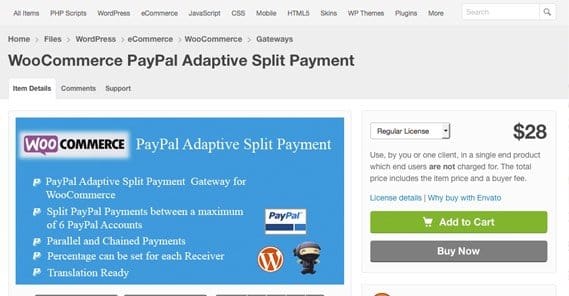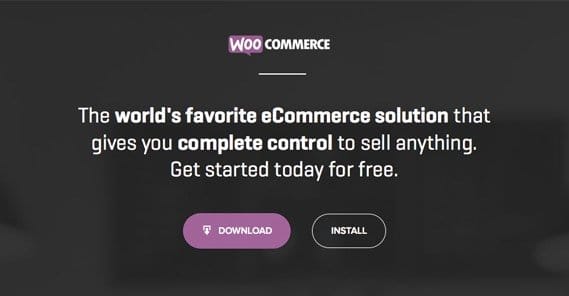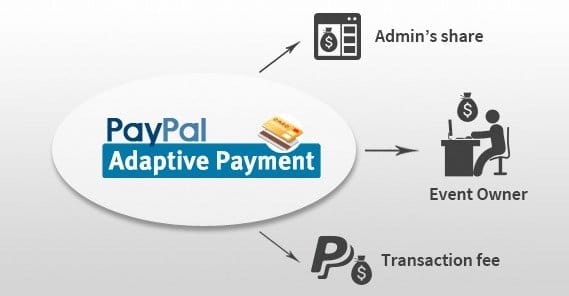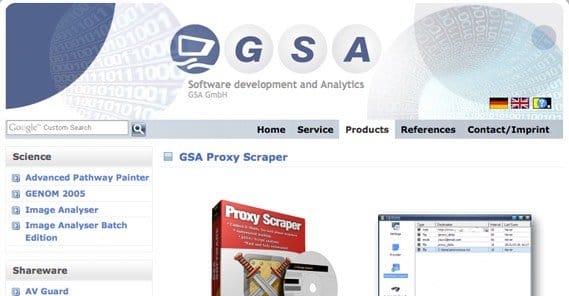Resell Products with Profit Sharing and Adaptive Payments

Have you ever wanted to be an affiliate marketer, but the brands and products you really want to sell aren’t available for resale? It’s a surprisingly common problem. Sure, you could try to sell through Amazon Affiliates; they probably have something in stock. The problem is, you don’t get a lot out of Amazon. Other affiliate networks might have stiff competition, harsh rules, or nothing you want to promote. You could compromise your ideals and sell anything that comes your way, or you could do what a few enterprising marketers do; forge their own affiliations.
Affiliate marketing, after all, comes from the concept of creation a relationship with a product producer. You approach someone like Nike and say “hey, I’ll sell your shoes, all I need is a cut of the price.” They allow it so long as you aren’t misrepresenting their brand. It’s cheap advertising for them; you’re doing all the work, they’re getting the payments, and if the payment is 5% lower than what it would be if they had made the sale themselves, so be it. That’s still probably cheaper than an equivalent investment in marketing. Heck, if you’re lucky, they might give you promotional material to help you close sales.
Affiliate networks exist for one reason; to make it easier for everyone involved to put the process into action. Companies don’t have to worry about 500 people coming up to them asking to sell their products. They don’t have to track and manage everything on their own. The network handles that. From the marketer’s end, they don’t have to be persuasive and get the companies to agree to an affiliation. The network does all of that.
When you’re doing it all yourself, you’re signing up for a lot of work. You need to make sure, then, that you’re capable of handling it and that you can give the company in question enough value to make it worth their time.
Some companies have affiliate networks of their own, and will require you to go through them. These aren’t the kind of companies I’m talking about. Some other companies will have a sales process for third party contractors, like you. They may or may not provide all the tools you need. I’m also not talking about them.
The companies I’m talking about are the small companies, the mid-sized businesses, that would welcome another advocate selling for them but who don’t have a process in place. For these companies, it’s up to you to forge a relationship and do as much of the work directly as you can.
You are, essentially, setting up a product resale system with profit sharing, rather than an affiliate system. You aren’t referring customers and getting paid when they convert. Instead, you’re sending in orders and taking a cut. The company gets an order with an address, and the money they agreed upon for your sales.
There are a few reasons I recommend small businesses over large companies. For one thing, large companies tend to be less receptive to one on one reseller relationships. Like I said, they may have their own affiliate programs, or contracts with networks they want you to go through. For another thing, the method I’m about to recommend requires PayPal, which many larger companies don’t particularly want to use.
The Tools
There are several things you need to be successful as a reseller.
First, of course, you need a company whose products you’ll be willing and able to resell. These should be products that may be able to be marked up so that you can take a cut and still give the full price to the company, or products with a large enough profit margin that the company can afford to give you a cut and still come out ahead. This company should be willing and receptive to your goals of reselling their products.
Second, you need a website. This is how you’ll be doing the majority of your reselling. You’ll be reviewing products, promoting products, writing blog posts, advertising; in short, putting a lot of work into it. I’ll give you more details on how to succeed later. This site should be run on WordPress primarily.
Third, you need a PayPal account. PayPal will be the payment method of choice, at least for the tool I’m going to give you. There are probably ways to do this with credit cards, but I haven’t investigated them as much; PayPal is fine for what I do.
Fourth, you need WooCommerce. WooCommerce is a stylish, functional, and customizable sales platform that gives you quite a bit of flexibility in your site design and what you’re trying to sell. It works just as well as a storefront as it does an affiliate platform, but you’re going to be going more towards the storefront side of things.
Fifth is the tool I’ve mentioned. The tool is WooCommerce PayPal Adaptive Split Pay, a plugin for WordPress and WooCommerce. It’s a cheap plugin, only $28 for a license. And no, that link isn’t an affiliate link or reseller account. Source direct.
How Split Payments Work
There are essentially two different types of split payments, but they both work on the same principle. The customer gives money to someone, and that money is split between you and the company that makes the product, according to predefined rules.
The first option is the parallel payments option. Say you have a range of different products from different sellers in your shop. The customer wants to buy three different products from different sellers, and adds them to their cart. When they check out, they will see that they have three individual orders with three different companies. Each of those payments will be sent through to the companies, with the payments split to give you your cut from each one. It’s all transparent, but it’s inconvenient.
The second option is chained payments, and this is what the plugin above excels at. In this scenario, when the customer adds the three products to their cart and pays, they see your store as the sole recipient. However, when the money arrives in your account, the plugin splits it and redirects the bulk of it to other accounts, those of the companies in question. It’s a single streamlined payment for the customer and for you, and your cut is left with you while the remainder of the money goes to the appropriate sellers.
With the adaptive split payments plugin, you can configure either option. The only restriction is the number of recipient accounts; only six can be configured per transaction. If you’re selling products from 2-3 companies, this is never an issue. It’s only an issue if you have enough products that a single payment could be split up amongst a large number of companies. Chances are, this won’t happen, particularly if you’re starting out and focusing on a small number of items.
Picking a Product to Resell
When you’re trying to pick a product to resell, you need to keep a lot of information in mind. I actually recommend making a spreadsheet with everything in one place, so you have easy to see pros and cons lists.
I also like to recommend digital products, if possible. It’s approximately a trillion times easier and less hassle to resell digital products than it is to resell physical products. They don’t require shipping. They don’t require accessories. They typically have larger margins of profit from which you can take a cut. On the other hand, software and other digital products tend to have more competition, for all of the above reasons.
A good product choice is either digital or small and light. It costs more to buy, to store, to ship, and to handle heavier and larger products. It’s easier to sell computer hardware than entire computers, for example.
Another thing to watch for is a low cost. You don’t want to go above, say, $200 for the price of your product. Sure, at that point, one conversion is a nice payday for you. On the other hand, it’s a lot harder to find people who will buy. If you’re reselling products that have a target market measured in numbers of employees, you’re going to have to be a hell of a salesman.
On the other hand, you don’t want to aim for something with too low a cost. Under $20 and you’re running into conversions where even volume doesn’t save you. If your profits per sale are measured in pennies, you better be able to guarantee thousands of sales a day if you want to make money. If you’re doing that, you’re probably not reading this post, now are you?
Do some research before you choose a product. It needs to be something that will sell, consistently, both now and in the future. You don’t want to pick something to invest in if that something is going to be obsolete in a year. You also don’t want to get into items that have inconsistent sales, like holiday items, unless you have the ability to make big investments and cover different holidays all year round.
You can find a lot of valuable product advice in this post, which is actually about starting a business reselling physical products bought in bulk. With this idea, you’re getting a 50-100% markup on your products, but you’re getting that because you’re buying from suppliers direct from China or another manufacturing country. Alibaba is your friend, here. Most of what I’m talking about, with digital products and 5-10% revenue shares, is more like affiliate resales. That’s another reason I recommend digital products; you don’t have to worry about buying in bulk and storing products.
Another bit of research you should do is looking for other prominent sellers of the product. With affiliate marketing this isn’t terrible detrimental, though one prominent reseller can dominate a niche with SEO and drive out others. With physical products, it’s a lot harder to beat out or undercut a power seller. These people have dominance in a niche and have the volume, the connections, and the investments necessary to undercut you until you wither before going back to business as usual.
Forging Relationships
The difference between what I’m promoting here and both reselling and affiliate marketing is the personal relationship. You’re not working through an impersonal third party, as is the case with an affiliate network. You’re also not working with a huge manufacturing company through a bulk seller and only looking to forge relationships with your customers.
With this sort of DIY affiliate reselling, you’re looking to make relationships everywhere. You’re going to want to make a solid relationship with the company who makes the product you’re selling. If you’re effective, and if they like you, they’ll give you resources, tips and information to make your sales better. You become more than just an affiliate; you’re a brand advocate.
On the other side of the coin, you’re forging relationships with customers, because customers are your lifeblood. If you have a reputation for quality support and communications, you’ll gain a positive image online and attract more people to you. On the other hand, if you disregard your customers and treat them as faceless sacks of money to be harvested and forgotten, your negative reviews will crop up and your business will struggle. Worse, the company you represent might catch wind of how you’re damaging the reputation of their product, and will cut you off.
Unfortunately, there’s not a lot of information I can give you for how to properly start a relationship with a business with products you want to resell. Essentially, all you need to do is contact them directly, preferably through an email to the appropriate person in their hierarchy, or through a direct phone call, whichever is more comfortable. You want to make a good first impression, and if possible you want to have proof that you’re a good seller.
This is a sort of advanced form of affiliate marketing, so I recommend that you actually start with some affiliate marketing. It’s hard to offer proof that you’re a quality, competent seller if you don’t have any sales experience. If you can prove that you’ve been a valuable seller for affiliate offers in the past, you can leverage that experience – and potentially even your audience – for whatever new item you want to sell.
Some companies will have sheets of prices and specifications for selling their items. This can be imposing; if they’re so well prepared, they’re probably going to put strict requirements on your performance. This is fine, if you can live up to them, but otherwise it might be a reasons to turn away before you make a promise you can’t keep.
Tips for Successful Sales
Given that you’re essentially setting up a WordPress blog, a WooCommerce storefront, and a PayPal plugin, you’re going to be working in the realm of affiliate marketing. Therefore, many of the tips that help you be successful with affiliate marketing will work for this sort of sales as well. Here are some of the best I’ve come up with in my research and experience.
- Product is everything. You’re going to be tailoring your site and your niche to your product, so everything relies on your ability to sell it, sell it well, and sell it in enough volume to support your costs and the profits you need to make.
- Be aware that you may fail. The first company you approach may not be interested in a reseller or affiliate arrangement. The second company might not have a product that sells as well as you want. There will be roadblocks. You need to have the funds to give you the time you need to experiment.
- Learn enough about SEO to know what to do and what not to do when you’re trying to rank a website. You don’t want to put work into carving a niche only to find that a more dominant seller can just suppress your website under the force of their own.
- Make sure your blog content and site design are original. There are thin affiliates and spam sites and scam blogs out there, and they tend to run off templates purchased or copied from black hat forums. These tend to promise fire-and-forget passive income, but they do so with a paint by numbers solution that looks like any of a hundred other sites, all of which are low quality. These just don’t work.
- Make sure there’s more to your site than a bland storefront and a basic homepage. Blogs are the key to successful affiliate sales; you want information, you want personality, you want everything that makes you look like a good resource.
- Try not to promote a list of different competing products. For one thing, many businesses don’t want to be compared side by side with their competitors. Someone always loses in that comparison. For another, competitor products mean you’re putting the effort into promoting two things when only one will sell. It also becomes less believable to realistically promote the benefits of numerous products all in the same niche.

 ContentPowered.com
ContentPowered.com









